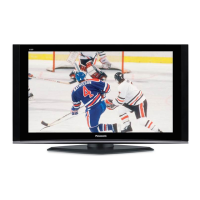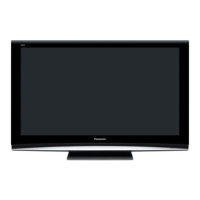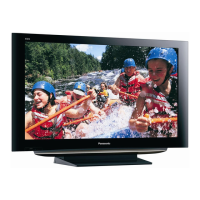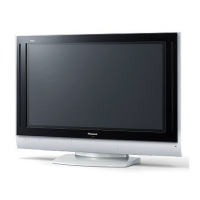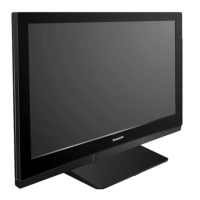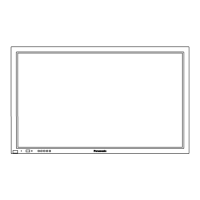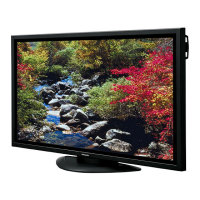Do you have a question about the Panasonic TH-50PZ700U and is the answer not in the manual?
Essential safety guidelines for product use and installation, covering electrical shock, fire, and general handling.
Compliance information regarding FCC rules for digital devices, including interference limits and user cautions.
List of included accessories with the television, such as remote control, batteries, and cables.
List of optional accessories available for purchase, like wall-hanging brackets and pedestals.
Step-by-step guide for attaching the TV pedestal, including warnings and cautions for secure assembly.
Instructions for securing the TV to a stable base using provided bands and screws.
Instructions for securing the TV to a wall using wire or clamps for enhanced safety.
Overview of signal sources, including antennas, cable boxes, satellite receivers, and their compatibility.
Guidance on connecting for optimal TV viewing, including antenna and cable box setups.
Instructions for connecting DVD recorders or VCRs for recording and playback functions.
Guidance for connecting satellite receivers to enjoy high-definition programming.
How to connect home theater systems and DVD recorders via HDMI for quality audio and video.
Diagrams illustrating various connection types for different audio/video signals.
Step-by-step guide for connecting an antenna to the TV for basic reception.
Guide for connecting DVD recorders or VCRs to the TV for recording and playback.
Connecting multiple sources like DVD recorders and satellite receivers simultaneously.
Connecting home theater systems and DVD recorders for an integrated entertainment setup.
Guidance on organizing and securing cables for a tidy and safe setup.
Initial step to power on the TV using the remote control or the unit itself.
Choosing the preferred language for the TV's on-screen interface and menus.
Setting the current date and time for accurate timekeeping and scheduling functions.
Automatically scanning and tuning available TV channels for immediate viewing.
Powering on the television unit to begin operation.
How to tune into specific TV channels using the remote control or keypad.
Information on secondary functions like SAP audio mode and SUB MENU shortcuts.
Adjusting the screen's aspect ratio for optimal viewing of different content formats.
Accessing pre-selected favorite channels quickly via the favorite list function.
How to register channels to the favorite list for easy recall.
Steps to recall and tune to favorite channels from the saved list.
Instructions for accessing the SD card slot on the television.
Guide on how to correctly insert an SD card into the designated slot.
Instructions for safely removing an SD card from the television.
Choosing the correct mode for SD card viewing and content recognition.
Navigating and selecting photos or video files from the SD card.
Options for viewing images, including basic display, slide shows, and image adjustments.
Adjusting viewing settings like display time, repeat function, and picture adjustments.
Configuring the slide show feature for photos, including display duration.
Fine-tuning picture settings such as mode, brightness, and color for displayed images.
Viewing special art and photography content from GalleryPlayer SD cards.
Selecting the input source for connected video devices like DVD players or VCRs.
Controlling connected HDAVI Control 2 equipment with the TV remote for convenience.
Accessing the EZ Sync menu to manage connected compatible equipment.
Choosing the specific equipment to control via the EZ Sync feature.
Using the TV remote to operate connected equipment through EZ Sync.
Selecting the correct input source for displaying a PC screen on the TV.
Activating the PC display input source to show computer output.
Adjusting PC display settings like sync, resolution, and position for optimal viewing.
Navigating menu functions to configure PC display adjustments.
Accessing the main TV menu system to adjust settings.
Navigating through different menu categories like Picture, Audio, and Setup.
Choosing specific settings or options within a selected menu category.
Making adjustments or selections within menu items using the remote control.
Detailed configuration options for picture, sound, and other TV settings.
Navigating to the Setup menu for system configurations and preferences.
Accessing the sub menu for quick access to frequently used functions.
Accessing the main menu to initiate EZ Sync setup.
Navigating to the Setup menu to access EZ Sync settings.
Configuring the EZ Sync feature, including enabling/disabling and link settings.
Activating or deactivating the EZ Sync function for connected equipment.
Setting EZ Sync to the 'On' state to enable automatic control.
Choosing audio output between home theater system speakers and TV speakers.
Controlling connected equipment using the TV remote, ensuring proper pointing.
Accessing the main menu to find the Lock function.
Navigating to the Lock menu for channel and program restriction settings.
Setting or entering a 4-digit password for accessing lock functions.
Choosing between Off, All, or Custom modes for channel and program locking.
Selecting specific items like Channel, Game, or Program to apply lock settings.
Applying the selected lock settings to the chosen items.
Locking specific channels or programs based on TV ratings (V-chip).
Specific instructions for locking individual channels.
Instructions for locking game content access.
Locking programs based on rating systems like MPAA and TV ratings.
Process for changing the existing lock password.
Accessing the main menu to manage channel settings.
Navigating to the Setup menu to access channel programming options.
Accessing the specific menu for programming and editing channels.
Choosing a function like Auto, Manual, or Signal meter for channel setup.
Applying the selected channel settings and configurations.
Automatic channel search and memory storage for active channels.
Choosing the signal source (cable or antenna) for channel reception.
Initiating automatic channel tuning and scanning.
Choosing between All, Analog, or Digital channel scanning modes.
Accessing the manual edit mode for channels, favorites, and captions.
Choosing which item (Caption, Favorite, Add) to edit.
Navigating to select specific channels for editing or favorite registration.
Saving the changes made during the channel editing process.
Discarding changes and exiting the edit mode without saving.
Verifying signal strength for optimal reception and troubleshooting.
Accessing the main menu to configure input labels and monitor output.
Navigating to the Setup menu for external device and CC settings.
Accessing settings for external devices or closed caption display.
Setting custom names for input labels or controlling monitor output.
Applying the selected input label or monitor out settings.
Labeling connected input terminals for easier identification during input selection.
Disabling monitor output for specific terminals to prevent signal issues.
Configuring Closed Caption display settings, including mode and digital settings.
Advanced settings for digital closed caption display, like text style and color.
Entering the digital closed caption settings menu.
Choosing specific digital captioning options like text size and font.
Resetting closed caption settings to their default values.
Accessing the main menu to locate the Timer function.
Navigating to the Timer menu to set automatic on/off functions.
Choosing which timer to configure: Sleep timer or On/Off timers (1-5).
Setting the on/off times, days, and channels for scheduled TV operations.
Configuring the sleep timer to automatically turn off the TV after a set duration.
Setting scheduled turn on/off times and days for specific events or programs.
Connecting external devices and powering them off initially.
Choosing the specific peripheral device to control using the TV's remote.
Entering remote control codes for third-party devices to enable operation.
Using the TV remote to control connected devices once codes are registered.
Procedure to find and register unknown remote control codes for peripheral devices.
Connecting camcorders for viewing captured video footage.
Connecting DVD players or set-top boxes for media playback.
Connecting audio systems or speakers for enhanced sound output.
Connecting a computer to the TV for displaying PC content.
Connecting HDMI compatible devices for high-definition digital video.
How to connect devices for EZ Sync functionality and integrated control.
Connecting specific Panasonic home theater components for EZ Sync operation.
Connecting DVD recorders and AV amplifiers for integrated audio-video setup.
Chart detailing remote control key functions for different modes (VCR, DBS/CBL, DVD).
Lists of codes for controlling various brands of cable converters and satellite receivers.
Extensive lists of remote control codes for VCR brands.
Comprehensive code lists for DBS/CBL, PVR, and DVD devices.
Explains the US movie rating system (MPAA) for content blocking.
Explains the US TV program rating system for content blocking.
Explains the Canadian English TV rating system for content blocking.
Explains the Canadian French TV rating system for content blocking.
Instructions for cleaning and maintaining the TV's screen surface.
Guidelines for cleaning the TV's exterior cabinet.
Instructions for cleaning and maintaining the TV pedestal.
Technical details regarding Closed Caption display and functionality.
Explanation of different aspect ratio options for image display.
Adjusting vertical position and size in ZOOM aspect mode.
Information on file formats and folder structure for SD card content.
Messages displayed when issues arise with SD card insertion or reading.
Messages related to GalleryPlayer content playback issues.
Important precautions for handling SD cards to prevent data or unit damage.
Information on using DIGITAL AUDIO OUT terminals for surround sound.
Technical explanation of EZ Sync and HDAVI Control functionality.
Details about connecting devices using the HDMI interface.
Information about side bar display in 4:3 mode and potential image retention.
Descriptions of available picture modes (Vivid, Standard, Cinema, Custom).
Table of supported input signals, frequencies, and compatibility.
Details on connecting a PC via the D-sub 15P connector and pin layout.
Troubleshooting common image noise issues and checking antenna connections.
Diagnosing and resolving channel interference and sound problems.
Troubleshooting distorted images from HDMI connections, checking cables and compatibility.
Steps to resolve issues with the TV remote control, including battery checks.
Common screen-related problems and their solutions, such as image retention.
Common sound-related issues and troubleshooting steps, including volume and speaker output.
Electrical power requirements for the television.
Details on the TV's power usage in different operating modes.
Specifications related to the plasma display panel, including size and resolution.
Specifications related to the audio output, including speaker power.
List and specifications of all available input and output terminals.
Key features and technologies integrated into the television model.
Physical dimensions and weight of the TV, with and without pedestal.
Details on warranty period, coverage for parts, labor, and panel.
Limitations and exclusions to the product's warranty, including wear and tear, misuse, and consequential damages.
Contact information for product support, operating assistance, and literature requests.
Information on purchasing replacement parts, accessories, and instruction books.
Contact details for obtaining service for products in Puerto Rico.
Warranty terms and conditions for Panasonic products purchased in Canada.
Specific limitations and exclusions to the Canadian product warranty.
Information on how to obtain warranty service, including contact and repair procedures.
Checking for the availability of an HD signal required for optimal viewing.
Connecting antennas or direct cables for HD reception.
Connecting standard definition cable boxes and satellite receivers.
Connecting external HD sources like cable boxes, satellite receivers, or DVD recorders.
Selecting the correct input source on the TV for external HD equipment.
Reasons why registering a new product is important: investment protection, safety notification, and product development.
Essential safety guidelines for product use and installation, covering electrical shock, fire, and general handling.
Compliance information regarding FCC rules for digital devices, including interference limits and user cautions.
List of included accessories with the television, such as remote control, batteries, and cables.
List of optional accessories available for purchase, like wall-hanging brackets and pedestals.
Step-by-step guide for attaching the TV pedestal, including warnings and cautions for secure assembly.
Instructions for securing the TV to a stable base using provided bands and screws.
Instructions for securing the TV to a wall using wire or clamps for enhanced safety.
Overview of signal sources, including antennas, cable boxes, satellite receivers, and their compatibility.
Guidance on connecting for optimal TV viewing, including antenna and cable box setups.
Instructions for connecting DVD recorders or VCRs for recording and playback functions.
Guidance for connecting satellite receivers to enjoy high-definition programming.
How to connect home theater systems and DVD recorders via HDMI for quality audio and video.
Diagrams illustrating various connection types for different audio/video signals.
Step-by-step guide for connecting an antenna to the TV for basic reception.
Guide for connecting DVD recorders or VCRs to the TV for recording and playback.
Connecting multiple sources like DVD recorders and satellite receivers simultaneously.
Connecting home theater systems and DVD recorders for an integrated entertainment setup.
Guidance on organizing and securing cables for a tidy and safe setup.
Initial step to power on the TV using the remote control or the unit itself.
Choosing the preferred language for the TV's on-screen interface and menus.
Setting the current date and time for accurate timekeeping and scheduling functions.
Automatically scanning and tuning available TV channels for immediate viewing.
Powering on the television unit to begin operation.
How to tune into specific TV channels using the remote control or keypad.
Information on secondary functions like SAP audio mode and SUB MENU shortcuts.
Adjusting the screen's aspect ratio for optimal viewing of different content formats.
Accessing pre-selected favorite channels quickly via the favorite list function.
How to register channels to the favorite list for easy recall.
Steps to recall and tune to favorite channels from the saved list.
Instructions for accessing the SD card slot on the television.
Guide on how to correctly insert an SD card into the designated slot.
Instructions for safely removing an SD card from the television.
Choosing the correct mode for SD card viewing and content recognition.
Navigating and selecting photos or video files from the SD card.
Options for viewing images, including basic display, slide shows, and image adjustments.
Adjusting viewing settings like display time, repeat function, and picture adjustments.
Configuring the slide show feature for photos, including display duration.
Fine-tuning picture settings such as mode, brightness, and color for displayed images.
Viewing special art and photography content from GalleryPlayer SD cards.
Selecting the input source for connected video devices like DVD players or VCRs.
Controlling connected HDAVI Control 2 equipment with the TV remote for convenience.
Accessing the EZ Sync menu to manage connected compatible equipment.
Choosing the specific equipment to control via the EZ Sync feature.
Using the TV remote to operate connected equipment through EZ Sync.
Selecting the correct input source for displaying a PC screen on the TV.
Activating the PC display input source to show computer output.
Adjusting PC display settings like sync, resolution, and position for optimal viewing.
Navigating menu functions to configure PC display adjustments.
Accessing the main TV menu system to adjust settings.
Navigating through different menu categories like Picture, Audio, and Setup.
Choosing specific settings or options within a selected menu category.
Making adjustments or selections within menu items using the remote control.
Detailed configuration options for picture, sound, and other TV settings.
Navigating to the Setup menu for system configurations and preferences.
Accessing the sub menu for quick access to frequently used functions.
Accessing the main menu to initiate EZ Sync setup.
Navigating to the Setup menu to access EZ Sync settings.
Configuring the EZ Sync feature, including enabling/disabling and link settings.
Activating or deactivating the EZ Sync function for connected equipment.
Setting EZ Sync to the 'On' state to enable automatic control.
Choosing audio output between home theater system speakers and TV speakers.
Controlling connected equipment using the TV remote, ensuring proper pointing.
Accessing the main menu to find the Lock function.
Navigating to the Lock menu for channel and program restriction settings.
Setting or entering a 4-digit password for accessing lock functions.
Choosing between Off, All, or Custom modes for channel and program locking.
Selecting specific items like Channel, Game, or Program to apply lock settings.
Applying the selected lock settings to the chosen items.
Locking specific channels or programs based on TV ratings (V-chip).
Specific instructions for locking individual channels.
Instructions for locking game content access.
Locking programs based on rating systems like MPAA and TV ratings.
Process for changing the existing lock password.
Accessing the main menu to manage channel settings.
Navigating to the Setup menu to access channel programming options.
Accessing the specific menu for programming and editing channels.
Choosing a function like Auto, Manual, or Signal meter for channel setup.
Applying the selected channel settings and configurations.
Automatic channel search and memory storage for active channels.
Choosing the signal source (cable or antenna) for channel reception.
Initiating automatic channel tuning and scanning.
Choosing between All, Analog, or Digital channel scanning modes.
Accessing the manual edit mode for channels, favorites, and captions.
Choosing which item (Caption, Favorite, Add) to edit.
Navigating to select specific channels for editing or favorite registration.
Saving the changes made during the channel editing process.
Discarding changes and exiting the edit mode without saving.
Verifying signal strength for optimal reception and troubleshooting.
Accessing the main menu to configure input labels and monitor output.
Navigating to the Setup menu for external device and CC settings.
Accessing settings for external devices or closed caption display.
Setting custom names for input labels or controlling monitor output.
Applying the selected input label or monitor out settings.
Labeling connected input terminals for easier identification during input selection.
Disabling monitor output for specific terminals to prevent signal issues.
Configuring Closed Caption display settings, including mode and digital settings.
Advanced settings for digital closed caption display, like text style and color.
Entering the digital closed caption settings menu.
Choosing specific digital captioning options like text size and font.
Resetting closed caption settings to their default values.
Accessing the main menu to locate the Timer function.
Navigating to the Timer menu to set automatic on/off functions.
Choosing which timer to configure: Sleep timer or On/Off timers (1-5).
Setting the on/off times, days, and channels for scheduled TV operations.
Configuring the sleep timer to automatically turn off the TV after a set duration.
Setting scheduled turn on/off times and days for specific events or programs.
Connecting external devices and powering them off initially.
Choosing the specific peripheral device to control using the TV's remote.
Entering remote control codes for third-party devices to enable operation.
Using the TV remote to control connected devices once codes are registered.
Procedure to find and register unknown remote control codes for peripheral devices.
Connecting camcorders for viewing captured video footage.
Connecting DVD players or set-top boxes for media playback.
Connecting audio systems or speakers for enhanced sound output.
Connecting a computer to the TV for displaying PC content.
Connecting HDMI compatible devices for high-definition digital video.
How to connect devices for EZ Sync functionality and integrated control.
Connecting specific Panasonic home theater components for EZ Sync operation.
Connecting DVD recorders and AV amplifiers for integrated audio-video setup.
Chart detailing remote control key functions for different modes (VCR, DBS/CBL, DVD).
Lists of codes for controlling various brands of cable converters and satellite receivers.
Extensive lists of remote control codes for VCR brands.
Comprehensive code lists for DBS/CBL, PVR, and DVD devices.
Explains the US movie rating system (MPAA) for content blocking.
Explains the US TV program rating system for content blocking.
Explains the Canadian English TV rating system for content blocking.
Explains the Canadian French TV rating system for content blocking.
Instructions for cleaning and maintaining the TV's screen surface.
Guidelines for cleaning the TV's exterior cabinet.
Instructions for cleaning and maintaining the TV pedestal.
Technical details regarding Closed Caption display and functionality.
Explanation of different aspect ratio options for image display.
Adjusting vertical position and size in ZOOM aspect mode.
Information on file formats and folder structure for SD card content.
Messages displayed when issues arise with SD card insertion or reading.
Messages related to GalleryPlayer content playback issues.
Important precautions for handling SD cards to prevent data or unit damage.
Information on using DIGITAL AUDIO OUT terminals for surround sound.
Technical explanation of EZ Sync and HDAVI Control functionality.
Details about connecting devices using the HDMI interface.
Information about side bar display in 4:3 mode and potential image retention.
Descriptions of available picture modes (Vivid, Standard, Cinema, Custom).
Table of supported input signals, frequencies, and compatibility.
Details on connecting a PC via the D-sub 15P connector and pin layout.
Troubleshooting common image noise issues and checking antenna connections.
Diagnosing and resolving channel interference and sound problems.
Troubleshooting distorted images from HDMI connections, checking cables and compatibility.
Steps to resolve issues with the TV remote control, including battery checks.
Common screen-related problems and their solutions, such as image retention.
Common sound-related issues and troubleshooting steps, including volume and speaker output.
Electrical power requirements for the television.
Details on the TV's power usage in different operating modes.
Specifications related to the plasma display panel, including size and resolution.
Specifications related to the audio output, including speaker power.
List and specifications of all available input and output terminals.
Key features and technologies integrated into the television model.
Physical dimensions and weight of the TV, with and without pedestal.
Details on warranty period, coverage for parts, labor, and panel.
Limitations and exclusions to the product's warranty, including wear and tear, misuse, and consequential damages.
Contact information for product support, operating assistance, and literature requests.
Information on purchasing replacement parts, accessories, and instruction books.
Contact details for obtaining service for products in Puerto Rico.
Warranty terms and conditions for Panasonic products purchased in Canada.
Specific limitations and exclusions to the Canadian product warranty.
Information on how to obtain warranty service, including contact and repair procedures.
Checking for the availability of an HD signal required for optimal viewing.
Connecting antennas or direct cables for HD reception.
Connecting standard definition cable boxes and satellite receivers.
Connecting external HD sources like cable boxes, satellite receivers, or DVD recorders.
Selecting the correct input source on the TV for external HD equipment.
Reasons why registering a new product is important: investment protection, safety notification, and product development.
| Screen Size | 50 inches |
|---|---|
| Display Type | Plasma |
| Resolution | 1920 x 1080 |
| Aspect Ratio | 16:9 |
| HDMI Ports | 3 |
| Component Video Input | 2 |
| S-Video Input | 1 |
| PC Input | 1 |
| HDTV Compatibility | Yes |
| Speakers | 2 x 10W |
| Viewing Angle | 160 degrees |
| USB Ports | 0 |
| Speaker Output | 20W |
| Built-in Tuner | ATSC |
